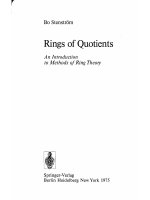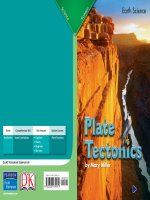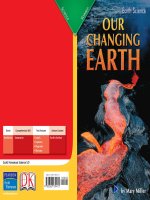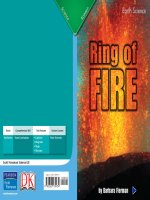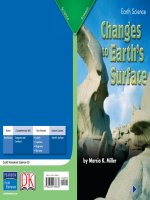earth science ring of fire
Bạn đang xem bản rút gọn của tài liệu. Xem và tải ngay bản đầy đủ của tài liệu tại đây (6.01 MB, 14 trang )
Scott Foresman Science 6.8
Genre Comprehension Skill Text Features Science Content
Nonfi ction Draw Conclusions • Captions
• Diagrams
• Maps
• Glossary
Plate Tectonics
ISBN 0-328-13993-9
ì<(sk$m)=bdjjde< +^-Ä-U-Ä-U
13993_01-04_CVR_FSD.indd Cover113993_01-04_CVR_FSD.indd Cover1 5/25/2005 3:52:25 PM5/25/2005 3:52:25 PM
Scott Foresman Science 6.8
Genre Comprehension Skill Text Features Science Content
Nonfi ction Draw Conclusions • Captions
• Diagrams
• Maps
• Glossary
Plate Tectonics
ISBN 0-328-13993-9
ì<(sk$m)=bdjjde< +^-Ä-U-Ä-U
13993_01-04_CVR_FSD.indd Cover113993_01-04_CVR_FSD.indd Cover1 5/25/2005 3:52:25 PM5/25/2005 3:52:25 PM
1. What is the Ring of Fire?
2. How is a subduction zone formed?
3. What part of the 1906 earthquake in San Francisco
caused the most damage? Why?
4.
According to the theory of
continental drift, the continent Pangaea gradually
split into the seven continents on Earth today.
Describe the evidence that supports this theory.
5.
Draw Conclusions Would a volcanologist
classify Mount Fuji as an active, dormant, or
extinct volcano? Explain.
What did you learn?
Extended Vocabulary
caldera
cinder cone
epicenter
fi ssure
magma
magnitude
volcanologists
Vocabulary
continental drift
core
crust
fault
lithosphere
mantle
plate boundary
plate tectonics
Picture Credits
Every effort has been made to secure permission and provide appropriate credit for photographic material.
The publisher deeply regrets any omission and pledges to correct errors called to its attention in subsequent editions.
Photo locators denoted as follows: Top (T), Center (C), Bottom (B), Left (L), Right (R), Background (Bkgd).
Opener: Reuters/Corbis; 4 (B) ©Jim Sugar/Corbis; 11 Reuters/Corbis; 15 (B) Tui De Roy/Minden Pictures;
16 ©Gary Braasch/Corbis; 17 (TR) Philippe Bourseiller /Photo Researchers, Inc., (B) Seiden Allan /PhotoLibrary;
20 (B) PhotoLibrary; 21 (TR) Paul Chesley/Getty Images; 23 Jeremy Bishop/Photo Researchers, Inc.
Scott Foresman/Dorling Kindersley would also like to thank: 15 (TR, CRA) Natural History Museum, London/DK Images.
Unless otherwise acknowledged, all photographs are the copyright © of Dorling Kindersley, a division of Pearson.
ISBN: 0-328-13993-9
Copyright © Pearson Education, Inc. All Rights Reserved. Printed in the United States of America.
This publication is protected by Copyright, and permission should be obtained from the publisher prior to any
prohibited reproduction, storage in a retrieval system, or transmission in any form by any means, electronic,
mechanical, photocopying, recording, or likewise. For information regarding permission(s), write to
Permissions Department, Scott Foresman, 1900 East Lake Avenue, Glenview, Illinois 60025.
3 4 5 6 7 8 9 10 V010 13 12 11 10 09 08 07 06 05
13993_01-04_CVR_FSD.indd Cover213993_01-04_CVR_FSD.indd Cover2 5/25/2005 3:52:46 PM5/25/2005 3:52:46 PM
by Barbara Fierman
13993_05-28_FSD.indd 113993_05-28_FSD.indd 1 5/25/2005 4:00:27 PM5/25/2005 4:00:27 PM
The outermost layer of Earth is the
crust. The thickness of the crust varies—
areas covered by oceans are about fi ve
kilometers thick, while areas of dry land can
be thirty kilometers thick. The layer below
the crust is the mantle. The outer part of
the mantle, like the crust, is solid. The inner
part is extremely hot, so hot that the rock
is partially melted.
The innermost layer of Earth is the
core. The core is quite dense as a result
of the pressure of the rock above it. The
temperature of the core is about 5,000˚C,
just about the same as that of the Sun.
The crust and the solid part of the
mantle make up the lithosphere. The
lithosphere is broken into pieces called
tectonic plates. These plates are of different
shapes and sizes. Most of the lithosphere
is actually under the oceans and other
bodies of water on Earth.
What You Already Know
2
This model shows a slice
through the Earth.
molten core
mantle
13993_05-28_FSD.indd 213993_05-28_FSD.indd 2 5/25/2005 4:00:44 PM5/25/2005 4:00:44 PM
In the early 1900s, a German scientist named
Alfred Wegener proposed a theory to explain the
movement of the plates. His theory, known as continental
drift, states that the continents drifted apart in the past, and
still continue to do so. Several pieces of evidence support this
theory. However, Wegener couldn’t account for the force that
caused the movement.
We gener’s theory also failed to explain many features of
the Earth’s crust. Currently, scientists rely on the theory of
plate tectonics to explain the appearance of Earth’s features.
According to this theory, Earth’s lithosphere is composed of
about twenty plates fl oating on a layer of partly melted rock.
The theory also explains many of Earth’s features, such as
how continents break apart, how mountain chains form,
how volcanoes erupt, or how oceans change size.
The areas where two plates meet are referred to as plate
boundaries. When plates move toward each other, they can
rise up and form mountains. When one plate slides below
another, faults, or breaks in Earth’s crust, may form. This
type of movement can cause earthquakes.
3
oceanic crust
continental crust
lithosphere
13993_05-28_FSD.indd 313993_05-28_FSD.indd 3 5/25/2005 4:00:51 PM5/25/2005 4:00:51 PM
Most volcanoes of the world are found along the boundaries
of major plates. The origin of volcanoes is closely related to the
movement of Earth’s plates. Earthquakes are vibrations, sometimes
very violent, that follow a release of energy in the Earth’s crust.
They also occur on or near plate boundaries.
If you plotted the locations of volcanic activity on a map, you
would see that most of them form a rim around the Pacifi c Ocean.
Actually, about 80 percent of the world’s earthquakes have occurred
along this rim. More than 75 percent of the world’s volcanoes
are located along the rim. Because of the extensive volcanic and
earthquake activity, the area has become known as the Ring of Fire.
You can use the map key to identify the Ring of Fire on the
map of volcanic regions shown below. Follow the Ring of Fire
as it stretches from New Zealand north through Indonesia, the
Philippines, and Japan; continues through eastern Russia and east
along the Aleutian Islands of Alaska; and then continues south along
the western coasts of North and South America. Notice the number
of volcanoes located along the Ring of Fire. These volcanoes are
located on the boundaries, or edges, of the Pacifi c plate.
Volcanic Regions
Ring of Fire plate boundary
volcano
Map Key:
Eurasian plate
Australian plate
Pacifi c plate
Antarctic plate
North American
plate
South
American
plate
Eurasian
plate
African plate
Indian
plate
4
13993_05-28_FSD.indd 413993_05-28_FSD.indd 4 5/25/2005 4:00:54 PM5/25/2005 4:00:54 PM
5
Cerro Negro, a volcano in
northern Nicaragua, has
erupted at least twenty
times since 1850.
13993_05-28_FSD.indd 513993_05-28_FSD.indd 5 5/25/2005 4:00:56 PM5/25/2005 4:00:56 PM
Earth’s crust is cracked into about
twenty pieces called tectonic plates.
Tectonic plates can be classifi ed
as continental or oceanic plates.
Continental plates are located mainly
under continents, and oceanic plates
are located mainly under the ocean.
Scientists estimate that the plates
range from twenty-fi ve to sixty miles
in thickness.
Tectonic plates are like rafts of
solid rock that fl oat on the mantle beneath them. As the mantle
moves, the tectonic plates move too. The moving plates pull away
from, collide with, or scrape past each other. Although the plates
move very, very slowly, the power of their collisions is great.
When two plates collide, the lighter plate is often forced
up over the heavier one. This action can cause cracks
in the mantle. Eventually, these cracks create
openings that allow molten, or melted,
rock to rise up out of Earth’s core.
Earth’s crust is split
into sections called
tectonic plates.
Moving Plates
6
13993_05-28_FSD.indd 613993_05-28_FSD.indd 6 5/25/2005 4:01:08 PM5/25/2005 4:01:08 PM
The action of tectonic plates results in different types of
boundaries between them. Divergent boundaries, such as those
of the Mid-Atlantic Ridge, separate from each other. When the
plates pull apart, magma, or molten rock, comes up from Earth’s
inner layers to form a new crust. Convergent boundaries form
when two plates meet in a collision, or one slides over the other.
Transform fault boundaries form when plates slide along one
another. Most volcanoes and earthquakes occur because of the
activity at plate boundaries.
Indonesia is located at the boundary of several plates. As
a result, more than 125 active volcanoes exist there. An
example is Merapi, on the island of Java. Merapi is the
most active composite volcano in Indonesia. It has
erupted at least sixty-eight times since 1548.
The mountain in the center is
Mt. Bromo, one of over 125 active
volcanoes in Indonesia.
Tectonic plates that pull apart
have divergent boundaries.
molten rock
boundary
boundary
7
13993_05-28_FSD.indd 713993_05-28_FSD.indd 7 5/25/2005 4:01:19 PM5/25/2005 4:01:19 PM
Why do plates move? Scientists have
proposed different explanations to answer the
question. One explanation is the convection
cell theory. It states that streams of magma
are pushed upward from deep within Earth
and out onto the ocean fl oor. As the molten
rock cools and hardens, it forms new rock
and causes the ocean fl oor to spread. This
process pushes the plates.
Another explanation is the plume
theory. This theory states that plumes, or
huge balls of extremely hot rock, exist in the
lower part of the mantle. These plumes rise up
into the upper part of the mantle as hot spots.
When a plume rises, it can spread out and cover
an area a few hundred miles across. A result of
this process is volcanic activity.
This is a cross-sectional
view of Earth’s crust,
mantle, and core.
crust
mantle
core
220 million years
ago
8
13993_05-28_FSD.indd 813993_05-28_FSD.indd 8 5/25/2005 4:01:28 PM5/25/2005 4:01:28 PM
The theory of plate tectonics is based on the theory of
continental drift. Proposed by Alfred Wegener in the early 1900s,
this theory states that one huge continent, Pangaea, existed on
Earth about 200–250 million years ago. After about 100 million
years, streams of molten rock in the mantle caused Pangaea
to split into pieces. These pieces eventually became the seven
continents that exist on Earth today.
We gener supported his theory with observations about the
shape of the Earth’s continents. He noticed that the continents fi t
together like pieces in a puzzle. For example, the eastern edge of
South America and the western edge of Africa seemed to fi t so
perfectly that they could have actually been joined at one time.
We gener also knew that certain types of rock had been
discovered on more than one continent. The discovery of
rock formations that extended over the current boundaries
of South America and Africa strongly supported the idea
that the continents were once joined.
The continental drift theory states
that continents drift, or move,
because they rest on tectonic
plates that form Earth’s crust.
200 million years
ago
135 million years
ago
10 million years
ago
9
13993_05-28_FSD.indd 913993_05-28_FSD.indd 9 5/25/2005 4:01:32 PM5/25/2005 4:01:32 PM
As you read earlier, the
movement of plates can cause
collisions along boundaries.
Sometimes, when two plates
collide, the heavier plate is forced
down into the mantle, forming what
is called a subduction zone. When
this happens, the Earth’s crust sinks
into the mantle. The rock along the
lower edge of the plate is melted by
molten rock, or magma. The magma
rises, forcing its way through the
lithosphere and the plate above it,
and fl ows out as a volcano. Since
many subduction zones exist in the
Ring of Fire, it is a region of intense
volcanic activity.
Many hot spots also exist within the Ring of Fire. Scientists
believe that the Hawaiian Islands formed over a hot spot. The
Pacifi c plate slid northwest and traveled over the hot spot.
Magma rose up through the ocean fl oor and formed a volcanic
island. As the plate continued to move, a magma eruption
created another island.
The fi rst islands formed, Kauai and Oahu, have no active
volcanoes at this time. Currently the Big Island of Hawaii is above
the hot spot. The active volcanoes there are Mauna Loa and Kilauea.
This view of Earth shows
the Pacifi c Ocean. The dots
indicate the Ring of Fire.
plates colliding
plates moving apart
10
13993_05-28_FSD.indd 1013993_05-28_FSD.indd 10 5/25/2005 4:01:35 PM5/25/2005 4:01:35 PM
The Kilauea volcano erupts at a
vent known as Puu Oo. Within
the cone is a crater enclosing a
lava lake. Note the fountains of
lava bursting forth from the lake.
11
13993_05-28_FSD.indd 1113993_05-28_FSD.indd 11 5/25/2005 4:01:40 PM5/25/2005 4:01:40 PM
Volcanoes
Volcanoes usually occur in areas where tectonic plates collide.
The collision of plates causes Earth’s crust to crack. Heat and
pressure become so intense that parts of the mantle melt. Molten
rock and hot gases are forced out through the cracks in the crust.
Volcanoes are classifi ed as active, dormant, and extinct.
An active volcano is one that could erupt at any time, even
though it is not necessarily in the process of erupting. There are
about 1,500 active volcanoes on Earth, with about fi fty in the
United States. A dormant volcano is one that has been inactive
for a long period of time. Mount Pinatubo is a volcano in the
Philippines, an island chain in the western Pacifi c Ocean. It was
dormant for six centuries before it erupted in 1991. The huge
eruption covered an area of
4,000 square kilometers with ash.
An extinct volcano is one that
shows no signs of erupting again.
Although dormant volcanoes
are currently inactive, they may still
continue to let off steam because
of the magma that exists inside
them. Dormant volcanoes may have
craters, bowl-shaped areas that hold
boiling lava. Lava is the name for
magma that has erupted. Craters are
formed by magma that is expelled
through a vent and forms a lava lake.
During dormant periods, the lava
in the lake cools and hardens over
the vent. When pressure builds up,
the volcano may erupt again in a
huge explosion.
Explosive Force
The girl in the photo uses a
bottle of soda to model the
process of a volcanic eruption.
She shakes the bottle gently
and then shakes it more
vigorously. When she opens
the bottle, the trapped gas,
carbon dioxide, spurts out.
12
13993_05-28_FSD.indd 1213993_05-28_FSD.indd 12 5/25/2005 4:01:57 PM5/25/2005 4:01:57 PM
During a volcanic eruption, magma and hot gases from
Earth’s mantle fl ow up. They erupt through a vent, or hole,
in the crust. They also may erupt through a vent at the side
of the volcano.
Different types of volcanoes produce different types
of eruptions. In less-violent eruptions, streams of lava fl ow
gently through vents in the volcano. Runny lava can travel
great distances before it solidifi es and stops. When the lava
is viscous, or thick and sticky, more violent eruptions may
take place. Lava fragments, hot rocks, ash, and dust may be
shot out over the surrounding area. A layer of ash several
feet thick may cover the area. In addition, volcanic ash can
be suspended in air for some time.
molten rock
(magma)
main vent (crater)
side vent
Inside a Volcano
13
13993_05-28_FSD.indd 1313993_05-28_FSD.indd 13 5/25/2005 4:02:28 PM5/25/2005 4:02:28 PM
fi ssure volcano
dome volcano
composite volcano
shield volcano
cinder cone volcano
caldera volcano
In a fi ssure volcano, lava
erupts from a long crack in
Earth’s surface. Lava may
erupt from several places
along the crack.
Dome volcanoes erupt
viscous lava, which slowly
builds up over the vent
and forms a dome.
These symmetrical
volcanoes usually
have steep sides and
cratered summits.
Shield volcanoes erupt
into broad, fl at mounds.
Basalt lava pours from
many side vents.
Hard fragments of lava, ash,
and volcanic gases erupt
from cinder cone volcanoes.
The volcanic material erupts
from a main vent and forms
a cone shape.
When a volcano is so
violent that it collapses in
on itself, a caldera, a large
bowl shape, is formed.
Types of Volcanoes
14
13993_05-28_FSD.indd 1413993_05-28_FSD.indd 14 5/25/2005 4:02:30 PM5/25/2005 4:02:30 PM
When an extremely forceful volcanic eruption
takes place, it can actually destroy the volcano. The
explosion causes the sides of the crater to collapse
and form a caldera—a wide bowl-shaped hole
more than a kilometer wide. An example is Mount
Mazama in southwestern Oregon. When it erupted
over 6,000 years ago, it left a caldera more than
nine kilometers wide and about two kilometers
deep. The caldera that was formed is now known
as Crater Lake.
Volcanic eruptions produce different types of
lava. One type, aa, is lava that cools quickly and
hardens into rough chunks of rock. Another type,
pahoehoe, is thin lava that cools more slowly and
hardens into smooth, ropy pieces. Pumice is lava
that cools and hardens into a lightweight rock
with many air bubbles in it. Pumice can be either
aa or pahoehoe.
Cerro Azul is a shield volcano located in the Galapagos Islands. The volcano
has erupted eight times, sometimes endangering the nesting zones of giant
tortoises. The caldera is small in diameter, but very deep.
pahoehoe
aa
15
13993_05-28_FSD.indd 1513993_05-28_FSD.indd 15 5/25/2005 4:02:35 PM5/25/2005 4:02:35 PM
Several famous volcanoes exist around the Ring of Fire.
Mount Paricutin, in Mexico, is an example of a cinder cone volcano.
Paricutin fi rst erupted in 1943, and the eruption continued for about
eight more years. Eruptions of gases and molten lava fell back around
the vent and built up the cone to 1,100 feet. The fi nal eruption left
a crater shaped like a funnel at the top of the cinder cone. Lava
continued to fl ow out onto the surface surrounding the cone.
Over a period of nine years, Paricutin covered an area of about
100 square miles with ash and destroyed the town of San Juan.
During this time, geologists around the world were able to observe
Paricutin and study its development.
Mount St. Helens had been inactive for approximately 123 years.
In 1978, scientists studying the volcano predicted that it would erupt
in the next ten years. In March of 1980, small explosions began,
with some ash and smoke coming out of the vent. In April the
north side began to bulge out, and in May the devastating eruption
occurred. The volcano ejected pieces of rocks, ash, and a cloud of
gases. In 1982, the area became Mount St. Helens National Volcanic
Monument. Visitors at the site can learn all about volcanoes.
Mount St. Helens erupted on May 18,
1980, spewing hot rocks, dust, and gases.
16
13993_05-28_FSD.indd 1613993_05-28_FSD.indd 16 5/25/2005 4:02:45 PM5/25/2005 4:02:45 PM
Mount Pinatubo, in the Philippines,
erupted on June 15, 1991. Three days
earlier, a cloud of volcanic ash and gas
rose up above the mountain. People in the
surrounding area felt the ground tremble
and noticed steam spurting from cracks
in the rocks. Scientists predicted the
eruption and warned people to leave the
area. About 300 people were killed, but
at least 5,000 lives were saved because of
early warning.
Mount Fuji is a composite volcano. Its
fi rst eruption occurred at least 3,000 years
ago. The most recent eruption was in
1707, when ash and huge pieces of rock
were ejected. In 2000, tremors occurred
in the area, and in 2003, steam was
detected coming from vents on the
northeastern side.
Mount Fuji, the highest
mountain in Japan, has
a large, circular crater
at the summit.
A thick coat of ash covered
the landscape after Pinatubo
erupted.
17
13993_05-28_FSD.indd 1713993_05-28_FSD.indd 17 5/25/2005 4:02:51 PM5/25/2005 4:02:51 PM
Locations that are likely to have volcanic activity are also likely
to have earthquake activity. As tectonic plates slide, scrape, and
collide, the movement creates cracks in the crust. These cracks are
called faults. Over time, pressure in the crust builds until it can’t be
contained any longer. Finally, the rock splits along the fault, and an
earthquake occurs.
Since most faults exist where plate boundaries collide, most
earthquakes happen where two or more plate boundaries meet.
However, faults can be located anywhere in the crust. Whenever
there is movement along a fault, an earthquake happens. Some
faults are close to the surface, while others are deep in the crust.
Earthquakes that occur close to the surface are more likely
to be felt and to do the most damage. Some earthquakes
originate within the upper mantle.
The street collapses.
This model of a street
illustrates the damage that
an earthquake can cause.
Buildings topple over.
Earthquakes
18
13993_05-28_FSD.indd 1813993_05-28_FSD.indd 18 5/25/2005 4:03:06 PM5/25/2005 4:03:06 PM
Each earthquake has a focus, which is the place where it
begins underground. Directly above the focus, on the surface,
is its epicenter. Energy moves away from the focus in the form
of seismic, or shock, waves. Different types of seismic waves
produce the earthquake’s initial jolt, shake the ground in all
directions, or produce a rolling, wavelike motion.
Seismologists, scientists who study earthquakes, measure
seismic waves and determine the magnitude, or size, of an
earthquake. They use this information to give each earthquake
a number rating on the Richter scale. The scale begins at zero
and increases by one number at a time. However, the amount
of ground movement is ten times the amount of the previous
number. While the Richter scale has no upper limit, the largest
earthquakes recorded on the scale have had a magnitude of
approximately 8.9.
Description
Richter
Magnitudes
Earthquake Effects
Average
Annually
Microearthquakes, not felt
Micro
Very minor
Minor
Light
Moderate
Strong
Great
Major
Less than 2.0
2.0–2.9
3.0–3.9
4.0–4.9
5.0–5.9
6.0–6.9
7.0–7.9
8.0 or greater
Generally not felt, but
recorded
Often felt, but rarely cause
damage
Shaking of indoor items,
rattling noises
Can cause major damage to
poorly constructed buildings
over small regions
Can be destructive in areas up
to one hundred miles across
Can cause serious damage
over larger areas
Can cause serious damages in
areas hundreds of miles across
About 8,000
per day
About 1,000
per day
49,000
(estimated)
6,200
(estimated)
800
120
18
1
19
13993_05-28_FSD.indd 1913993_05-28_FSD.indd 19 5/25/2005 4:03:16 PM5/25/2005 4:03:16 PM
Locations along the Ring of Fire are
especially inclined to earthquake activity.
The Pacifi c plate, almost 9,000 miles
wide, is the largest tectonic plate. On its
eastern boundary, it meets the North
American plate. The San Andreas
fault is located at the junction of these
two plates. The fault is 10 miles deep
and stretches north along the coast of
California for about 750 miles. About
twenty major earthquakes occurred
along the San Andreas fault in the
twentieth century.
The 1989 earthquake in San Francisco
caused buildings to collapse.
The San Andreas fault is
an example of a strike-
slip fault. The fault runs
vertically through rock.
Rock on one side slips and
scrapes past the other.
20
13993_05-28_FSD.indd 2013993_05-28_FSD.indd 20 5/25/2005 4:03:19 PM5/25/2005 4:03:19 PM
The city of San Francisco is located near the fault line and
has been the site of major earthquakes. In 1906 a magnitude
8.3 earthquake, known as the Great San Francisco Earthquake, hit
the city in the early morning hours. Buildings crumbled into the
streets, gas pipes broke, and the city’s main water pipelines broke.
Dozens of fi res broke out, but without water, fi refi ghters couldn’t
put them out. The fi res raged through the city for three days. In
the end, about 90 percent of the total damage was due to fi re.
The United States Geological Survey predicted that a
moderate-to-large earthquake would hit San Francisco between
1988 and 2018. In October 1989 their prediction proved to
be correct when an earthquake shook the city again. This
earthquake occurred just before a World Series game was to
be played in Candlestick Park. Measuring 7.1 on the Richter
scale, the earthquake was responsible for the destruction
of 100,000 buildings and the collapse of a section of the
San Francisco Bay Bridge.
Other devastating earthquakes have occurred in locations
along the Ring of Fire, such as Kobe, Japan; Northridge,
California; and Anchorage, Alaska. Because the likelihood of
earthquake activity is so great in this region, schoolchildren
living there routinely perform earthquake drills in school.
Schools conduct the drills so that students will know what
to do if an earthquake occurs.
Students in Japan practice regular earthquake drills.
21
13993_05-28_FSD.indd 2113993_05-28_FSD.indd 21 5/25/2005 4:03:29 PM5/25/2005 4:03:29 PM
Scientists who specialize in the study of volcanoes are called
volcanologists. Volcanologists monitor volcanic and earthquake
activity in order to make more accurate predictions and save more
lives. Their work involves a variety of research activities. They may
climb mountains to search through a lava fl ow or crawl into craters
to collect samples of rock and volcanic gases. By analyzing the gases,
they can sometimes predict changes in a volcano’s activity.
Many volcanologists work for the U.S. Geological Survey. This
government agency maintains fi ve observatories in the United States.
The scientists at the location in Hawaii predict, monitor, and study
the activity of the Kilauea and Mauna Loa volcanoes. At the site in
Washington State, scientists monitor Mount St. Helens and other
volcanoes in the Cascade Mountain range. In Alaska, geologists
from the agency and the University of Alaska monitor the twenty
active volcanoes there and eighty others in the North Pacifi c.
Volcanologists use special types of equipment and tools in
their research. Equipment includes heat suits and gloves to
protect them when they observe active volcanoes, and helmets
and face masks to protect them from falling rocks, dust,
and poisonous gases. They use special thermometers called
thermocouples to record the temperature of lava fl ows.
Volcanologists expect more volcanic and earthquake activity
to occur in the Ring of Fire. Hopefully, they will be able to predict
it in time to save lives.
Research
The zigzag lines recorded on this seismogram
indicate the size of an earthquake.
22
13993_05-28_FSD.indd 2213993_05-28_FSD.indd 22 5/25/2005 4:03:52 PM5/25/2005 4:03:52 PM
A volcanologist wears a
special heat suit while
observing a lava eruption.
23
13993_05-28_FSD.indd 2313993_05-28_FSD.indd 23 5/25/2005 4:03:56 PM5/25/2005 4:03:56 PM
Glossary
caldera a large depression formed when a volcanic
crater collapses
cinder cone a volcano formed from ash and loose bits of
rock from an explosive volcanic eruption
epicenter the point on Earth’s surface that lies directly
above the focus of an earthquake
fi ssure a jagged crack in Earth’s crust, caused
by earthquakes, volcanic activity, and
plate movements
magma hot liquid rock and gases inside Earth
magnitude a measurement of the size of an earthquake
based on the energy released and the size of
the seismic waves created
volcanologists scientists who study volcanoes
24
13993_05-28_FSD.indd 2413993_05-28_FSD.indd 24 5/25/2005 4:04:10 PM5/25/2005 4:04:10 PM
1. What is the Ring of Fire?
2. How is a subduction zone formed?
3. What part of the 1906 earthquake in San Francisco
caused the most damage? Why?
4.
According to the theory of
continental drift, the continent Pangaea gradually
split into the seven continents on Earth today.
Describe the evidence that supports this theory.
5.
Draw Conclusions Would a volcanologist
classify Mount Fuji as an active, dormant, or
extinct volcano? Explain.
What did you learn?
Extended Vocabulary
caldera
cinder cone
epicenter
fi ssure
magma
magnitude
volcanologists
Vocabulary
continental drift
core
crust
fault
lithosphere
mantle
plate boundary
plate tectonics
Picture Credits
Every effort has been made to secure permission and provide appropriate credit for photographic material.
The publisher deeply regrets any omission and pledges to correct errors called to its attention in subsequent editions.
Photo locators denoted as follows: Top (T), Center (C), Bottom (B), Left (L), Right (R), Background (Bkgd).
Opener: Reuters/Corbis; 4 (B) ©Jim Sugar/Corbis; 11 Reuters/Corbis; 15 (B) Tui De Roy/Minden Pictures;
16 ©Gary Braasch/Corbis; 17 (TR) Philippe Bourseiller /Photo Researchers, Inc., (B) Seiden Allan /PhotoLibrary;
20 (B) PhotoLibrary; 21 (TR) Paul Chesley/Getty Images; 23 Jeremy Bishop/Photo Researchers, Inc.
Scott Foresman/Dorling Kindersley would also like to thank: 15 (TR, CRA) Natural History Museum, London/DK Images.
Unless otherwise acknowledged, all photographs are the copyright © of Dorling Kindersley, a division of Pearson.
ISBN: 0-328-13993-9
Copyright © Pearson Education, Inc. All Rights Reserved. Printed in the United States of America.
This publication is protected by Copyright, and permission should be obtained from the publisher prior to any
prohibited reproduction, storage in a retrieval system, or transmission in any form by any means, electronic,
mechanical, photocopying, recording, or likewise. For information regarding permission(s), write to
Permissions Department, Scott Foresman, 1900 East Lake Avenue, Glenview, Illinois 60025.
3 4 5 6 7 8 9 10 V010 13 12 11 10 09 08 07 06 05
13993_01-04_CVR_FSD.indd Cover213993_01-04_CVR_FSD.indd Cover2 5/25/2005 3:52:46 PM5/25/2005 3:52:46 PM

